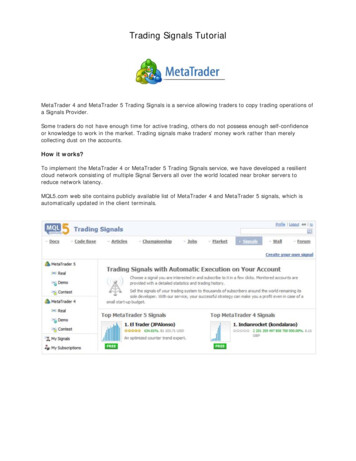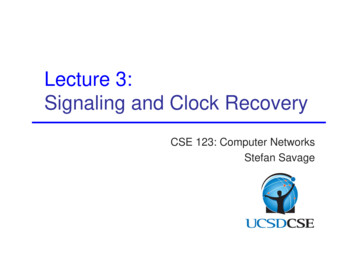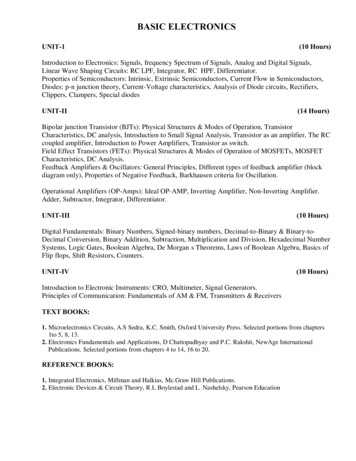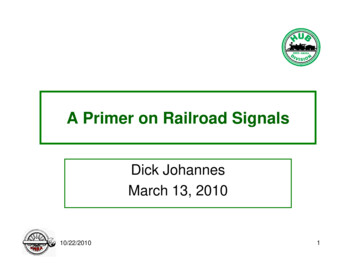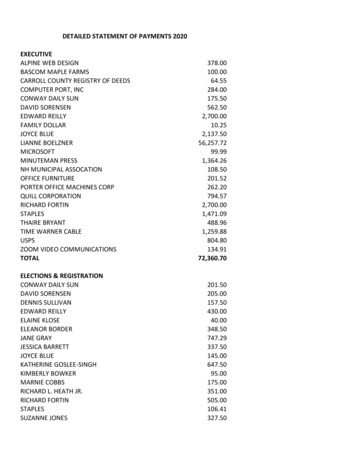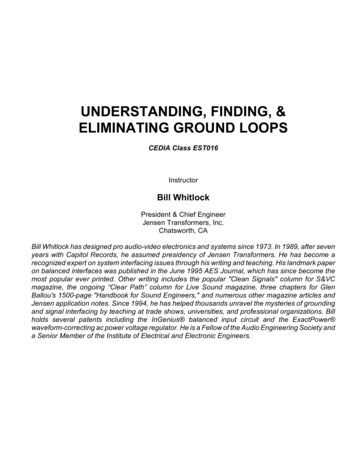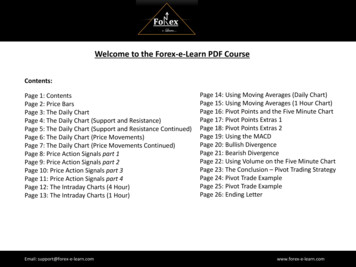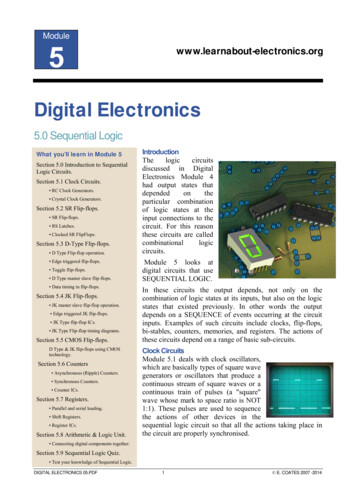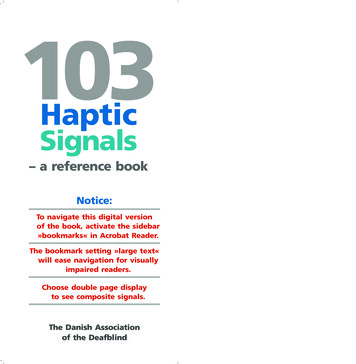
Transcription
103HapticSignals– a reference bookNotice:To navigate this digital versionof the book, activate the sidebar»bookmarks« in Acrobat Reader.The bookmark setting »large text«will ease navigation for visuallyimpaired readers.Choose double page displayto see composite signals.The Danish Associationof the Deafblind
103 Haptic Signals– a reference bookISBN 978-87-989299-4-9 The Danish Associationof the Deafblind, June 2010English version, August 2012Editor: Gerd NielsenThe illustrations in this book show AnetteRosenqvist making haptic signals on theback of Dorte Eriksen who is deafblind.Anette Rosenqvist and Dorte Eriksen aresome of the Danish pioneers in the development of haptic communication.Photos and graphic production:Niels Holst – Graphic Studio.This book is produced by The DanishAssociation of the Deafblind in collaboration with Centre for Sign Language– The Interpreter Training Program andThe Information Centre for AquiredDeafblindness.This book is produced with fundingfrom the Danish Ministry of Education.
Preface103 Haptic Signals– a reference bookis a collection of the most commonhaptic signals used by deafblindpersons and persons with visualand hearing impairments in Denmark.The signals have been developedand chosen by deafblind personsand persons with visual and hearing impairments in collaborationwith their contact persons and areference group consisting of representatives from different parts ofthe deafblind community in Denmark.The book can be used for trainingand further development of hapticcommunication. It is our hope thatthe use of haptic signals will become a natural element withinvisual interpretation to all deafblind persons. This form of visualinterpretation can enhance thepossibilities of active participationon equal terms for deafblind persons and persons with visual andhearing impairments in varioussocial situations.3
Haptic communication is still developing. Previous published signalsare collected and standardized inthis book so it can be a platformfor further development of signals.What are haptic signals?The word haptic is Greek andmeans touch. Haptic signals are anumber of signals, which are‘drawn’ onto the body – typicallyon the upper part of the back orthe upper part of the arm. Theyprovide the possibility of a detailedvisual interpretation during communication.Using haptic signals deafblind persons and persons with visual andhearing impairments are able to receive information about e.g. theirsurroundings or the mood and facial gestures of other people whilecontinuing their conversation uninterrupted.If a person smiles, if people laughafter a joke, if your dinner partnerraises his glass to make a toast, ifthe meeting commences or if acomment is said with irony. Allthese situations could lead to misunderstandings.4
By using haptic signals deafblindpersons and persons with visualand hearing impairments are ableto receive the same information one.g. their back that others receivethrough their sight, and this givesthem the opportunity to participate on equal terms in social interaction.Behind the bookThe reference group that has followed the publication closely consists of representatives from: Centre for the Deaf, the Deafblind Consultants’ Department Centre for Sign Language – theInterpreter Training Program The Danish Association of SignLanguage Interpreters The Danish Association of Contact Persons for the Deafblind The Information Centre forAcquired Deafblindness The Danish Associationof the DeafblindThe book is produced by The Danish Association of the Deafblind incollaboration with Centre for SignLanguage – the Interpreter Training5
Program and The Information Centre for Acquired Deafblindness.The book is produced with funding from the Danish Ministry ofEducation.6
How to usethis bookThe 103 haptic signals are illustrated and described in alphabetic order with one signal on each page.That makes it easy to look up a signal.On page 13 you will find a list ofcategories, which gives an overview of which signals to use in thefollowing situations: Description of persons,moods and atmospheres Description of surroundingsand rooms DirectionsColoursFood and drinksOthersIt might be a good idea for newusers of haptic signals to start bychoosing one category and learnthe signals from that single category. When the signals are learnt andthey have become a natural part ofthe communication, you can take itto the next level and start usingsignals from the other categories.7
All signals in this book are described so they can be used without previous knowledge of SignLanguage.However, some haptic signals aremade with inspiration from familiar signs in Danish Sign Language.In this book, those signals aremarked with the symbolSL8
How to use hapticcommunicationAdjust the signalsto your needsMany deafblind persons or personswith visual and hearing impairments chose the signals most relevant for their use and adjust themto their individual needs. For example if you often do talks, itmight be relevant for you to focuson the signals that describe thesurroundings and other people’sreactions. That way it will be easierfor you to adjust your talk fromthe reactions of the audience.An individual adjustment of thesignals could be experimentingwith the size of the signals. Perhaps understanding the signals iseasier if they are carried out withlarger or smaller movements, withvariation in pressure, on the backof the hand or on the thigh? Therecipient and the one giving thesignals can agree on this in advance.In this reference book most signalsare given on the back or the upper9
arm, but all the signals can bedone on other parts of the body.The meaning of a signal can beemphasised by enlarging the movements, repeating the movement oradjusting the pressure that is usedcarrying out the sign.E.g. the signal for LAUGHING is repeated as long as the laughter continues, and if a person is very angry, the signal ANGRY can be madewith stronger pressure on the back.Description ofsurroundings and roomsHaptic communication is very suitable for description of the surroundings e.g. a room and how it is furnished.10
Start by drawing the outline of theroom on the back using two fingers. Tables, doors, persons – andother items in the room – can thenbe drawn in their actual shape inaccordance to the first outline onthe back. This will provide a referential frame that can be used fordescribing actions going on in theroom hereafter.Tip:First, make a dot on the back to indicate where the person is situatedin the room. Afterwards, place objects and other persons accordingto the recipient’s position in theroom .Description of persons,moods and atmospheresMany haptic signals are linked topeople’s reactions e.g. in a conversation. Is the other person smiling,does she seem angry or disappointed? Is the conversation interrupted? All this information is important to receive in order to respondimmediately to the present moodof the conversation and to be anequal participant in the conversation.11
Often deafblind persons and persons with visual and hearing impairments are not told until after aconversation how the other personreacted during their conversation.Information on mood can be difficult to convey openly.On the other hand, it can be crucial for a good conversation if youare told with discrete haptic signalsthat the person you are talking tois e.g. crying, looking disappointedor happy.Tip:When the conversation begins,you can draw an outline of theother person’s face on the back.After that, eyes, mouth and otherfeatures can be placed within theface outline and be used duringthe following conversation e.g. toindicate a smiling mouth, blinkingeyes etc.Enjoy hapticcommunication12
IndexAlphabetically17 AHEADstraight ahead43 DRUNK18 ANGRY45 EMBARRASSING19 ANNOYED20 APPLAUDING21 BLACK22 BLINKING23 BLUE24 BLUSHING25 BORED26 BREAK27 BROWN28 CAKE29 CHOCOLATE30 CHEERS32 COFFEE33 COUGHING34 CRYING35 CURIOUS36 DANGER37 DIRECTION38 DISAPPOINTED39 DOOR40 DOUBTFUL44 EATING46 END– the end47 FINISHED48 FLIRTING49 FOOD50 FRUIT51 GREEN52 GREY53 HAND54 HAPPY55 HELLOsaying hello56 HICCUPS57 HUG58 IMPATIENT59 INTERESTED60 INTERRUPTING61 IRONIC62 KNOCKING63 LAUGHING41 DRINKING64 LAVATORY– toilet42 DROPPING– something65 LEAVING– walking
66 LEFT92 RED67 LESS93 RIGHT68 LEVEL94 ROOM69 LOOKING95 SAD70 LOOP SYSTEM96 SERIOUS71 MOBILE– mobile phone97 SHAKING72 MOMENT– wait a moment99 SOUR73 MORE74 MOVE– move over75 NAME76 NERVOUS77 NO78 NODDING79 NOISE80 NUMBERS1, 2, 3 etc.98 SMILING100 SPEAK – you101 SPEAKING– someone else102 SPEAK SOFTLY104 SPEAK UP106 SPEECH108 STOP109 SURPRISED110 TALKING111 TEA81 ORANGE112 THINKING82 PERHAPS113 TIRED83 PHONE(tele)phone114 TYPING84 POSITION116 WALKING85 PRICE117 WATER86 PURPLE118 WHAT ?87 QUESTION119 WHITE88 QUIET120 WRITING89 RAINING121 YAWNING90 READING122 YELLOW91 READY123 YES115 WAITING
Indexby cathegoriesDescription of persons,moods and CCUPSTIREDHUGWAITINGIMPATIENTYAWNINGSOUR13
Description ofsurroundings and RQUESTIONDROPPINGsomethingQUIETRAININGEND– the endREADINGFINISHEDHANDINTERRUPTINGREADYROOMSPEAK – youKNOCKINGSPEAKINGsomeone elseLAVATORYtoiletSPEAK SOFTLY!LEAVINGLOOKINGLOOP SYSTEMMOBILE phoneMOMENTwait a momentSPEAK WRITING14
DirectionsAHEADMOVEStraight aheadmove REYYELLOWFood and beverageCAKEEND – the EAEATINGWATER15
OthersFINISHEDNUMBERS – 1,2, 3 etc.LEAVING?are we leaving PERHAPSLESSPRICEMOREWHAT?NOYES16
AHEADSL– Straight aheadPlace a flat, outstretched handagainst the back, little finger handside towards the back and fingertips pointing upwards.Move the hand upwardsin a vertical line.See also: RIGHT page 93 LEFT page 6617
ANGRYPlace the index fingertipagainst the back.Draw a ‘mountain peak’ onthe back, indicating the peakingemotions.18
ANNOYEDSLBend the fingers and place allthe fingertips against the back.Move the hand from side to sidein a ‘shaking’ movement.19
APPLAUDINGTwo-hand signalPlace both flat, outstretched handsagainst the back, palms towardsthe back. In turn, clap the handsagainst the back.Repeat the movement as longas people are applauding.When the applause dies out,clap more gently and let the handsslide downwards.20
BLACKSLPlace a flat outstretched handpalm against the upper arm.Point the fingertips upwards.Turn the hand downwards‘15 minutes’ anti-clockwise.21
BLINKINGSL– Blinking one’s eyesStretch the fingers and turn thethumb downward creating spacebetween index finger and thumb.Place the edge of the hand withthe thumb and index finger sideagainst the back. Shortly tilt thehand forward down and thenback again by bending the wrist.Repeat the movement.See also: TIRED page 11322
BLUESLUse a flat, outstretched hand.Place the palm against the upperarm, the fingertips pointing forward.Move the hand upwards followingthe arm and in a curve to theright.23
BLUSHINGSLStretch the fingers and place thehand flat against the back, fingertips pointing upwards.Move the hand upwards whilespreading the fingers like a blushspreading across a person’s face.24
BOREDPlace a flat, outstretched handagainst the back, fingertipspointing upwards.Slowly, one at a time, drumthe fingers against the back.Repeat the movement.25
BREAKStretch the index and middlefingers, closing the rest of thefingers.Make a ‘cut’ into the upper armusing the index and middle fingers.Hold the ‘cut’ for a moment.26
BROWNSLClose one hand making a fist,and place the little finger handside against the upper arm.Move the hand round creatinga circle.27
CAKESLBend fingers and hand.Place all fingertips on the shoulderand remove them again.28
CHOCOLATESLStretch the index and middle fingers, closing the rest of the fingers.Place the index and middle fingersagainst the upper arm, fingertipspointing upwards. Make a shortmovement downwards along thearm and outwards.Repeat the movement.29
CHEERSSLCompound signalDRINKING double-clap1) DRINKINGShape the hand as if holdinga glass.Loosely grab around the upperarm, the little finger hand sidedownwards.Move the hand up the arm.Keep the hand in this positionas long as people are toasting.30
2) Double-clapMake a double-clap against the upper arm when people drink fromtheir glasses.31
COFFEESLMake a fist and place the littlefinger hand side towards theshoulder.Move the hand around in a circleshaped movement.32
COUGHINGSLShape a hand as if holding a glass.Loosely grab around the upperarm, the little finger hand sidedownwards.Move the hand up and down aslong as the coughing continues.33
CRYINGSLPlace the index fingertip againstthe back.Quickly draw a vertical line downthe back using the index fingertip.Move the hand to the right andquickly draw a vertical line parallelto the first.See also: SAD page 9534
CURIOUSTSPlace the index fingertip againstthe back.Make a short movement downwards and away from the backusing the fingertip.Repeat the movement.See also: INTERESTED page 5935
DANGERPlace the index fingertip againstthe back or any other place ofthe body.Draw a big cross.Tip:Carry out the signal on thepart of the body closest to you,if a dangerous situation arises.See also: MOVE page 7436
DIRECTIONPlace a flat, outstretched hand,the little finger hand side againstthe back.Move the hand in the relevantdirection.Signal LOOKING page 6937
DISAPPOINTEDStretch the fingers and place a flathand against the back, fingertipspointing upwards.Move the hand down in a slowmovement.38
DOORSL– Position of the doorTwo-hand signalPut one hand on top of the other.Stretch fingers on both hands andplace the little finger hand sidesagainst the back.Tilt the upper hand up and downlike a door opening and closing.Tip:If you have already described theroom outline, then place the doorwhere it is situated in the room.39
DOUBTFULStretch the index and middlefingers, closing the rest of thefingers.Place the index and middle fingersagainst the back and shift fromfinger to finger, only one fingerat a time touching the back.Signal PERHAPS page 8240
DRINKINGSL– Do you wantsomething to drink?Shape a hand as if holding a glass.Loosely grab around the upper armwith the little finger hand sidedownwards.Move the hand up the arm.See also: EATING page 4441
DROPPINGSL– dropping somethingMake a fist and place thumband index finger hand sideagainst the back.Move the hand down the backwhile opening it to indicatethat something is being dropped.42
DRUNK– a person is drunkPlace the index fingertipagainst the back.Draw a winding line upwards usingthe fingertip.43
EATINGPlace the index fingertipagainst the upper arm.Draw a circle on the upper armusing the fingertip.Signal FOOD page 4944
EMBARRASSINGSLPlace a flat hand, fingers spreadagainst the back, fingertips pointing upwards.Slowly bend the fingertips againstthe back until the hand is madeinto a fist.45
ENDSL– the endStretch the fingers and place theedge of the hand against theupper part of the back or shoulder.Make a sweeping movement fromside to side using the edge of thehand against the back.Signal FINISHED page 4746
FINISHEDSLStretch the fingers and place theedge of the hand against theupper part of the back or shoulder.Make a sweeping movement fromside to side using the edge of thehand against the back.Signal THE END page 4647
FLIRTINGTwo-hand signalPlace both index fingertips againstthe back next to one another.Draw the two halves of a heartsimultaneously.48
FOOD- Food is served now.Place the index fingertip againstthe upper arm.Draw a circle on the upper armusing the fingertip.Signal EATING page 4449
FRUITSLBend the finger tips and placethem against the upper arm.Rotate the hand clockwise andback. Make sure the fingertipstouch the upper arm duringboth rotations.50
GREENSLStretch the fingers and placea flat palm against the upper arm,fingers pointing upwards.Move the hand downwardsand outwards from the armin a sweeping movement.51
GREYSLUse a flat, outstretched hand.Clap the palm against the upperarm while pointing the fingertipsforward.Repeat with a light sweepingmovement upwards.52
HAND– Someone is raising his / her handTwo-hand signalHand 1 pokes twice against theupper arm using the index fingertip while hand 2 indicates theperson’s position in the roommaking a double poke againstthe back.Tip:If you have already describedthe outline of the room, then placethe person where he or sheis located in the room.53
HAPPYPlace the tip of the thumb andthe index finger – some distanceapart – against the back.Draw a double curve usingthe two fingers.See also: SMILING page 9854
HELLO– a person says helloand wants to shake hands.Place a flat, outstretched handjust behind the elbow, the backof the hand upwards.Clap two times behind the elbowusing the back of the hand.See also: NAME page 7555
HICCUPSSLShape the hand as if holdinga glass.Loosely grab around the upperarm, the little finger hand sidedownwards.Move the hand quickly up anddown with a jerk.56
HUG– somebody wants to give a hugGently grab the upper arm withyour hand and give the arm a littlesqueeze.Tip:With a gentle pressure towardsone of the arms, you can signalwhether the person aims to hugtowards the right or left cheek.57
IMPATIENTPlace a flat, outstretched handon the back, fingertips pointingupwards.Drum quickly and impatientlywith shifting fingers againstthe back.Repeat the movement.58
INTERESTEDPlace the index fingertip againstthe back and write the letter ’i’(including the dot).See also: CURIOUS page 3559
INTERRUPTING– have to interruptPlace a flat hand, palm downon one shoulder.Hold the position for a little while.60
IRONICPlace the index fingertip againstthe back and rotate the handclockwise making a ’dot’ onthe back.Repeat the movement.Tip:Make the signal for IRONY immediately when the mood of ironystrikes the conversation. This makesit easier for the recipient to understand that an ironic point is beingmade.61
KNOCKINGSL– Knocking at the doorClose one hand making a fist,and knock on the back usingyour knuckles.See also: DOOR page 3962
LAUGHINGSLBend the fingertips, spread thefingers and place the fingertipsagainst the back.‘Scratch’ the hand up and downthe back.Repeat the movement as longas the laughter continues.See also: HAPPY page 5463
LAVATORY– I am going to the lavatory / toiletPlace the index fingertip againstthe upper arm.Draw a little cross on the upperarm using the fingertip.64
LEAVING– shall we leave?Stretch the index and middle fingers, closing the rest of the fingers.Let the index and middle fingers‘walk’ across the back.Signal WALKING page 11665
LEFTPlace a flat, outstretched hand,little finger hand side againstthe back and fingertips pointingupwards.Move the hand at an angleupwards to the left.66
LESSSLPlace a flat, outstretched hand,palm down and the little fingerhand side against the upper arm.Move the hand down the upperarm.See also: LEVEL page 6867
LEVELTSPlace a flat, outstretched hand,palm down and the little fingerhand side against the middle ofthe upper arm.Move the hand up the armindicating a higher level (MORE)or down the arm indicatinga lower level (LESS).See also: MORE page 73 LESS page 6768
LOOKINGPlace a flat, outstretched hand,the little finger hand side againstthe back.Move the hand in the relevantdirection.Signal DIRECTION page 3769
LOOP SYSTEM– Switch to loop systemPlace the index fingertipagainst the upper arm.Write the letter T onthe upper arm using the fingertip.Draw a circle around the T.T stands for ‘Teleslynge’– the Danish word for loop system.70
MOBILE– a mobile (tele)phone is ringingStretch the thumb and little finger,closing the rest of the fingers.Place the thumb and little fingertips against the upper arm and tiltthem one at a time against thearm.Signal (tele) PHONE page 8371
MOMENT– wait a momentStretch the index finger,closing the rest of the fingers.Place the index finger side againstthe upper arm and move it backand forth against the arm.Signal WAITING– wait a moment page 11572
MORESLPlace a flat, outstretched hand,palm down and the little fingerhand side against the upper arm.Move the hand up the upper arm.See also: LEVEL page 6873
MOVE– Move overUse a flat, outstretched hand.Place the back of the hand againstthe upper arm.Press the hand gently towardsthe arm.Tip:Press the arm in the directionyou want the deafblind personto move.74
NAME– of persons in the roomPlace the index fingertip againstthe back.Write the person’s name or initialswith capital letters on the back.As far as possible, write each letterin one movement without liftingthe finger.75
NERVOUSSLShape the hand as if holdinga glass, using only the thumband index fingers.Place the two fingertips on the backand move them simultaneouslydown the back in a zigzagmovement.76
NOSLUse a flat, outstretched hand,palm against the back and fingertips pointing upwards.Move the hand from side to sidea couple of times.Signal SHAKING his head page 9777
NODDINGClap gently on the back, shoulderor upper arm using a flat, outstretched hand.Signal YES page 12378
NOISESLTwo-hand signalUse both flat, outstretched hands,turn the thumbs downwardsmaking space between theindex fingers and thumbs.Place both little finger hand sidesagainst the back, fingertips pointing towards each other.Open and close both hands usingoutstretched fingers.Repeat the movement on differentparts of the back.79
NUMBERS– 1, 2, 3 etc.Place the index fingertip againstthe back. Write the figure usingthe index finger.If possible, write the figurein one continuous movement,without lifting the finger.Signal PRICE page 8580
ORANGESLUse a flat, outstretched hand andturn the thumb downwards making space between the index fingerand thumb.Place the thumb and index fingerhand side against the upper arm.Open and close the hand usingoutstretched fingers.Repeat the movement.81
PERHAPSStretch the index and middle fingers, closing the rest of the fingers.Place the index and middle fingersagainst the back and let fingersshift in touching the back.Signal Doubtful page 4082
PHONE– a (tele)phone is ringingStretch the thumb and little finger,closing the rest of the fingers.Place the thumb and little fingertips against the upper arm andtilt them one at a time againstthe arm.Signal MOBILE page 7183
POSITIONPlace the index fingertip againstthe back.Show with a poke (or by drawing asimple figure) on the back wherethe person or object is placed inthe room.Tip:If you have already described theroom outline, then place the person or object where he / it can befound relative to the outline.84
PRICEPlace the index fingertipagainst the back.Write the figure usingthe fingertip.If possible, write the figure in onecontinuous movement, without lifting the finger.Signal NUMBERS page 8085
PURPLESLStretch the index and middlefingers, closing the rest ofthe fingers.Place the index and middle fingersagainst the upper arm and makea small horizontal, curved movement.86
QUESTIONPlace the index fingertipagainst the back.Draw a question markusing the fingertip.87
QUIETPlace the index fingertipagainst the back.Draw a horizontal lineusing the fingertip.88
RAININGSL– It is rainingTwo-hand signalSpread fingers on both handsslightly and place them flat againstthe back, fingertips pointing upwards.Move the hands downwards whiledrumming the fingers against theback like rain falling.89
READINGSLUse a flat, outstretched hand,backside against the back andfingertips pointing upwards.Move the hand back and forth horizontally.Turn the hand over and make asweeping movement, as if turninga page in a book.90
READYSLTwo-hand signalPlace both hands,palms against the back.Move the hands simultaneouslyupwards and outwards whileseparating them towards each side.91
REDSLStretch the index finger, closing therest of the fingers.Place the index finger hand sideagainst the upper arm and movethe finger forward, drawing a horizontal line on the upper arm withthe index finger hand side.92
RIGHTPlace a flat, outstretched hand,little finger hand side against theback, fingertips pointing upwards.Move the hand upwardsto the right.93
ROOMTwo-hand signalDraw the outline of the roomon the recipient’s back usingtwo fingers.Then table, doors, persons etc.can be drawn representing theiractual shape/position relative tothe outline on the back.Tip:First, make a dot inside the outlineindicating the recipient positionin the room. Secondly, mark upobjects and other persons relativeto the recipient’s position.94
SADSLPlace the index fingertip againstthe back.Slowly draw a vertical line downthe back using the fingertip.Move the hand to the right andslowly draw a vertical line parallelto the first.See also: CRYING page 3495
SERIOUSSLPlace a flat, outstretched handagainst the back, fingertips pointing upwards and the little fingerhand side against the back.Move the hand down the backin a vertical line.96
SHAKING– one’s headUse a flat, outstretched hand,palm against the back and fingertips pointing upwards.Move the hand from side to sidea couple of times.Signal NO page 7797
SMILINGPlace the index fingertip againstthe back.Draw a curved (smiling) lineusing the fingertip.See also: HAPPY page 5498
SOURPlace the index fingertipagainst the back.Draw a curved (sulky) lineusing the fingertip.99
SPEAK– your turn to speak– you can take the floorPoke twice against the upper armusing the index fingertip.100
SPEAKING– someone else is speaking– someone has taken the floorPoke twice against the back usingthe index fingertip.Place the poke on the back indicating the position of the speakingperson in the room.See also: NAME page 75101
SPEAK SOFTLYCompound signalTALKING LESS1) TALKING, two-hand signalUse both flat, outstretched hands,turn the thumbs downwardsmaking space between the indexfingers and thumbs.Place both little finger handsides against the back, fingertipspointing towards each other.Open and close both handswith outstretched fingers.Repeat the movement.102
2) LESSPlace a flat, outstretched hand,palm down and the little fingerhand side against the upper arm.Move the hand downthe upper arm.103
SPEAK UPCompound signal. TALKING MORE1) TALKING, two-hand signalUse both flat, outstretched hands,turn the thumbs downwardsmaking space between the indexfingers and thumbs.Place both little finger handsides against the back, fingertipspointing towards each other.Open and close both handswith outstretched fingers.Repeat the movement.104
2) MOREPlace a flat, outstretched hand,palm down and the little fingerhand side against the upper arm.Move the hand up the upper arm.105
SPEECH– someone is giving a speechCompound signalINTERRUPTING TALKING1) INTERRUPTINGPlace a flat hand, palm downon one shoulder.Hold the position for a little while.106
2) TALKING, two-hand signalUse both flat, outstretched hands,turn the thumbs downwardsmaking space between the indexfingers and thumbs.Place both little finger handsides against the back, fingertipspointing towards each other.Open and close both handswith outstretched fingers.Repeat the movement.107
STOPPlace a flat, outstretched hand,palm against the back.Point the fingertips upwards.Hold this hand positionfor a moment.108
SURPRISEDSLPlace a flat, outstretched hand,palm against the back, the littlefinger hand side pointing downwards.Move the hand upwards and awayfrom the back in a rapid, sweepingmovement.109
TALKINGSLTwo-hand signalUse both flat, outstretched hands,turn the thumbs downwardsmaking space between the indexfingers and thumbs.Place both little finger hand sidesagainst the back, fingertipspointing towards each other.Open and close both handsusing outstretched fingers.Repeat the movement.110
TEAPlace the index fingertipagainst the upper arm.Write a T on the upper armusing the fingertip.111
THINKINGStretch the index and middlefingers, closing the rest ofthe fingers.Place the index and middle fingertips against the back and let them‘walk’ for a while back and forthalong the back.112
TIREDUse a flat, outstretched hand,turn the thumb downwardsmaking space between the indexfinger and thumb.Place the thumb and index fingerhand side against the back andshortly tilt the hand forwarddown and then back again to showeyelids closing shut and opening bybending the wrist.See also: YAWNING page 121113
TYPINGSL– typing on a PCTwo-hand signalPlace both hands flat against theback, spreading the fingers a bitand fingertips pointing upwards.Let the fingers ‘type’ against theback as if typing on a keyboard.114
WAITINGStretch the index finger, closing therest of the fingers.Place the index finger side againstthe upper arm and move it backand forth against the arm.Signal MOMENT– wait a moment page 72115
WALKINGSLStretch the index finger and themiddle finger, closing the rest ofthe fingers.The index and middle fingers‘walk’ across the back.Signal LEAVING page 65Tip:Profitably, the fingers can ‘walk’across the back in the same direction as the person is moving according to the recipient’s position.116
WATERSLPlace a flat, outstretched handagainst the upper arm, fingerspointing forward and the palmor the back of the hand againstthe upper arm.Move the hand down while thefingers
This book is produced by The Danish Association of the Deafblind in collabo-ration with Centre for Sign Language – The Interpreter Training Program and The Information Centre for Aquired Deafblindness. This book is produced with funding from the Danish Ministry of Education. 103 Haptic Signals –
